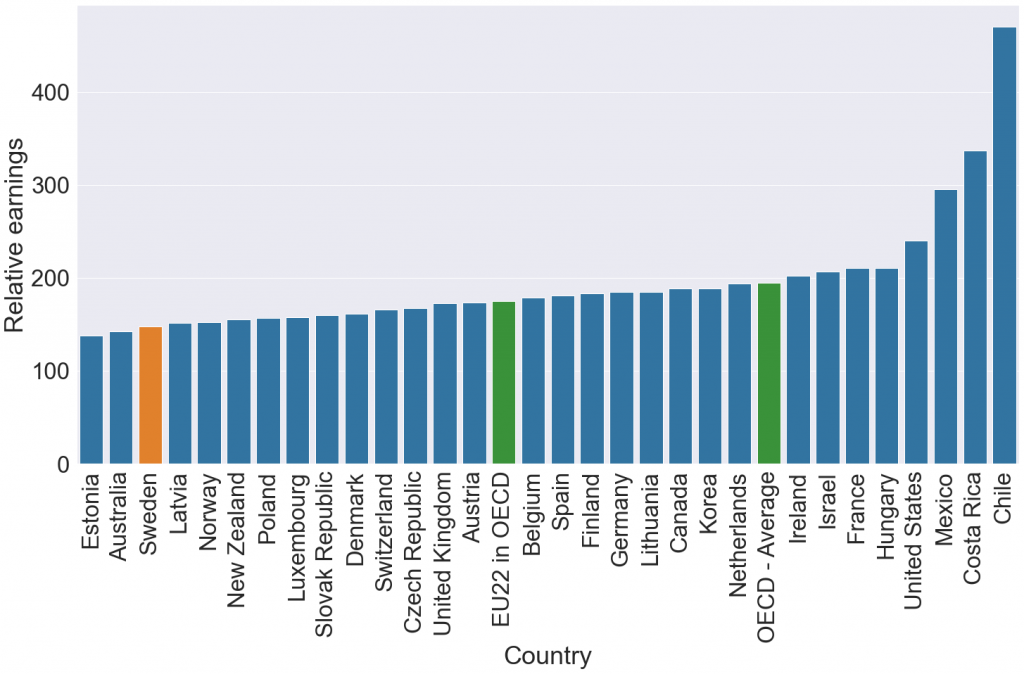
How Sweden squanders its most important talent – Part 3: What happens after graduation?
- by Ankit Gupta
In the previous blogs, we highlighted what makes Sweden an attractive place for foreign PhD students to pursue their PhD study and showed some statistics on research done by foreign students at the Department of Information Technology, Uppsala University. In this third blog, we will try to highlight the socio-economic scenario in which recent PhD graduates from outside the EU find themselves in Sweden, and showcase the utility of good immigration policy and how the new legislation might affect it in the next blog.
What happens after graduation from the PhD?
Sweden has a low employment rate for PhD graduates compared to other countries. According to the Organisation for Economic Co-operation and Development (OECD) report on Sweden (OECD, 2021), the employment rate of PhD graduates in Sweden is low (91%, ranking 27/36) compared to other OECD and partner countries. This might be attributed to a mismatch in the research focus in academia and the Swedish industry needs.
Sweden has a low salary compared to other OECD countries for degree holders. Sweden ranks very low (30/32) in the internationally comparable earnings of 25-64 year-old full- and part-time workers with a Master’s, doctoral or equivalent education degree, as shown in Figure 1. This may already contribute to PhD students -foreign and native- leaving Sweden after getting their degree.

Sweden has a low salary difference between different academic qualifications. Sweden ranks very low (30/33) in the proportional difference between earnings of 25-64 year-old adults with Master’s or Doctoral degree and those with only upper secondary or post secondary non-tertiary education which is 1.43 (OECD, 2021). This could lead to less motivation to pursue a PhD after completing a MSc in Sweden. For foreign PhD graduates this could be a reason to move to another country where the earnings are higher.
Most foreign PhD’s leave Sweden after graduation. All of these facts together may lead to the surprising statistic from the Kahlroth article (Kahlroth, 2020) that states that 62% of foreign doctoral students leave Sweden within three years after obtaining their degree, whereas the same statistic for Netherlands, and Finland is 50% (Rud et al., 2015), and 35% (Myklebust, 2020) respectively. This already paints a rather pessimistic view of PhD studies in Sweden, and further hindrance in smooth integration might accelerate the exodus further.
References
Kahlroth, M. (2020, 08 26). Higher education institutions in Sweden – 2020 status report. Swedish Higher Education Authority (UKÄ). Retrieved 10 14, 2021, from https://english.uka.se/about-us/publications/reports–guidelines/reports–guidelines/2020-08-26-higher-education-institutions-in-sweden—2020-status-report.html
Myklebust, P. (2020, October 17). What makes international students want to stay on or go? University World News. https://www.universityworldnews.com/post.php?story=20201016145617425
OECD. (2021, 10 29). Profile of graduates and new entrants. OECD.Stat. Retrieved 10 29, 2021, from https://stats.oecd.org/Index.aspx?datasetcode=EAG_GRAD_ENTR_SHARE
Rud, I., Wounterse, B., & van Elk, R. (2015, September 01). Stay rates of foreign PhD graduates in the Netherlands. CPB.nl. Retrieved February 25, 2022, from https://www.cpb.nl/sites/default/files/publicaties/download/cpb-background-document-stay-rates-foreign-phd-graduates-netherlands.pdf
In the previous blogs, we highlighted what makes Sweden an attractive place for foreign PhD students to pursue their PhD study and showed some statistics on research done by foreign students at the Department of Information Technology, Uppsala University. In this third blog, we will try to highlight the socio-economic scenario in which recent PhD…